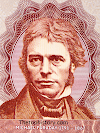Johann Gutenberg is known as the inventor of the printing press. What it did, in fact, was to improve the already used movable type in such a way that it enabled the printing process to be printed in greater numbers and with greater accuracy.
Johann Gutenberg | Inventor of the Printing Press
 |
| Johann Gutenberg |
Introduction And Early Life
We know very little about Gutenberg's biography. All we know is that he was
born in Germany around 1400 in the city of "Mez." In the art of
printing, he made these additions around the middle of the same century, while
his famous work was the "Gutenberg Bible" which was printed in Mainz
around 1454.
(Interestingly, Gutenberg's name did not appear on any of his books, nor on
his Bible, although there is no mention that this Bible was printed on a
machine he built. It seems that he Was not a good businessman.
He never amassed much wealth from his invention. He was involved in several
lawsuits, one of which was the abandonment of his own machine in favor of his
partner, Joe Hannost. He was born in Mainz in 1468.
The Invention of the Printing Press (Johann Gutenberg)
Johann Gutenberg is credited as the inventor of the printing press. What it
did, in fact, was to improve the already used movable type in such a way that
it enabled the printing process to be printed in greater numbers and with
greater accuracy. No invention comes entirely from the mind of a single
individual, obviously, the printing press is one such invention.
Molded seals and seal rings have been in use since ancient times. Several
centuries before Gutenberg, the template printing method was practiced in
China, while a book printed there around 868 has also been discovered. Even in
the West, people were familiar with all these processes before Gutenberg.
Printing from a template made it possible to produce many versions of a
single book. This method, however, had the drawback that for each new book, a
completely new mold of wood blocks or boards had to be prepared each time.
Every procedure for printing a large number of books was impossible.
Gutenberg's main invention is generally considered to be the movable type
printing press, while the movable type printing press was invented in China in
the mid-11th century AD by a man named P Shek. Its characters were made of
clay, which was not durable, but people in China and Korea made several improvements.
Before Gutenberg, metal letters were used in writing.
Korea Established the Industry for the Manufacture of Printing
As early as the fifteenth century, the Kingdom of Korea had established a
large industry for the manufacture of printing characters. Nevertheless, it
would be wrong to imagine that P Shegg was an influential person.
Established the Printing System in Europe
The first reason is that Europe did not learn the method of movable type
from China, but invented it on its own. The second reason is that the method of
printing movable characters could never get popular recognition in China.
It was widely used in China after borrowing the modern printing system from
Europe. There are four basic elements of a modern printing system. The first is
the method of moving letters, which involves the process of connecting and
arranging letters second printing machine.
Thirdly good printing light and fourthly a good material i.e. paper on
which to print. The paper had already been invented in China many years before
Tsai Lun himself and was in general use in the West long before Gutenberg's
time.
It was the only era of printing method which was in ready condition. Made
available to Gutenberg. The remaining three components were also worked on to
some extent. Gutenberg made various improvements to it.
For example, he developed a suitable alloy for letters. A template for
correctly aligning letter pieces, suitable for glossy printing lighting and
printing also produced "Kal".
Gutenberg's work as a whole is far greater than his individual
contributions. It is more important because it makes all the components of
printing efficient production integrated into the system. Unlike all other
pre-existing inventions, printing had the potential for mass production. A
rifle is a far more effective weapon than a bow and arrow.
Similarly, a printed book is no less valuable than a handwritten book.
Gutenberg's invention was not a revival of an old method, nor was it a series
of additions, but a complete production process.
Gutenberg's Developments
We can get an outline of Gutenberg's impact on world history by comparing
the developments in China and Europe in later years. At the time of Gutenberg's
birth, both areas were technically equally advanced. However, after the
invention of the modern printing system, the development of Europe accelerated.
While in China, where the intaglio printing method continued to prevail, the pace of development was relatively slow, it may be an exaggeration to say that the development of printing was the main driving force behind this distinction.
It is also worth noting that only three people on our list are
from the five centuries before Gutenberg, while sixty-six people are from the
five centuries after his death.
It is also worth noting that only three people on our list are from the
five centuries before Gutenberg, while sixty-six people are from the five
centuries after Gutenberg's death Born in centuries. This proves that
Gutenberg's invention played a pivotal role in launching the revolutionary
development of modern times.
It goes without saying that even if Alexander Graham Bell had not existed,
the telephone would still have been invented. Rather, it may have been invented
in the same period, the same can be said about many other inventions.
Without Gutenberg, the invention of the modern printing system would have been delayed for generations. In view of the profound impact of the printing system on future history, Gutenberg deserves a prominent place on this list.






0 Comments